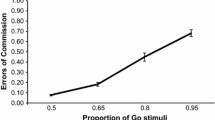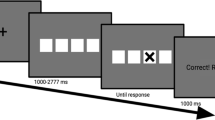Abstract
In the current investigation, we examined the changes in performance, task-related thoughts (TRT), and task-unrelated thoughts (TUT) over four sessions of a modified sustained attention to response task (SART). Eighteen participants completed a clockwise manual selection SART (Head and Helton in Conscious Cogn 22:913–919, 2013) and a conscious thought questionnaire once a week for four weeks. Response times and errors of commission oscillated over sessions in line with a motor strategy interpretation of the SART. As participants became faster in the task, they made more commission errors. The conscious thought questionnaire failed to show a relationship between errors of commission and TRT and TUT on the SART at either a between-subject or within-subject level of analysis. Commission errors in the SART may be better measures of executive motor control and response strategy than perceptual decoupling.



Similar content being viewed by others
References
Bakan P (1955) Discrimination decrement as a function of time in a prolonged vigil. J Exp Psychol 50:387–390
Beilock S, Bertenthal B, Mccoy AM, Carr TH (2004) Haste does not always makewaste: expertise, direction of attention of speed versus accuracy in performing sensorimotor skills. Psychonomic Bull Rev 11:373–379
Binford JB, Loeb M (1966) Changes within and over repeated sessions in criterion and effective sensitivity in an auditory vigilance task. J Exp Psychol 72:339–345
Cole TB, Patetta MJ (1988) Hunting firearm injuries. Am J Public Health 78:1585–1586
Docktree PM, Kelly SP, Roche RA, Hogan MJ, Reilly RB, Robertson IH (2004) Behavioral and physiological impairments of sustained attention after traumatic brain injury. Cogn Brain Res 20:403–414
Docktree PM, Bellgrove MA, O’Keefe FM, Moloney P, Aimola L, Cartoon S et al (2006) Sustained attention in traumatic brain injury (tbi) and healthy controls: enhanced sensitivity with dual-task load. Exp Brain Res 168:218–229
Green AL, Helton WS (2011) Dual-task performance during a climbing traverse. Exp Brain Res 215:307–313
Grier RA, Warm JS, Dember WN, Matthews G, Galinsky TL, Szalma JL et al (2003) The vigilance decrement reflects limitations in effortful attention not mindlessness. Hum Factors 45:349–359
Hancock PA (2013) In search of vigilance: the problem of iatrogenically created psychological phenomena. Am Psychol 68:97–109
He J, Becic E, Lee YC, McCarley JS (2011) Mind wandering behind the wheel performance and oculomotor correlates. Hum Factors 53:13–21
Head J, Helton WS (2012) Natural scene stimuli and lapses of sustained attention. Conscious Cogn 21:1617–1625
Head J, Helton WS (2013) Perceptual decoupling or motor decoupling? Conscious Cogn 22:913–919
Head J, Russell PN, Dorahy MJ, Neumann E, Helton WS (2011) Text-speak processing and the sustained attention to response task. Exp Brain Res 216:103–111
Helton WS (2009) Impulsive responding and the sustained attention to response task. J Clinic Exp Neuropsychol 31:39–47
Helton WS, Russell PN (2011a) Working memory load and the vigilance decrement. Exp Brain Res 212:429–437
Helton WS, Russell PN (2011b) Feature absence-presence and two theories of lapses of sustained attention. Psychol Res 75:384–392
Helton WS, Warm JS (2008) Signal salience and the mindlessness theory of vigilance. Acta Psychol 129:18–25
Helton WS, Hollander TD, Warm JS, Matthews G, Dember WN, Wallaart M et al (2005) Signal regularity and the mindlessness model of vigilance. Br J Psychol 96:249–261
Helton WS, Kern RP, Walker DR (2009) Conscious thought and the sustained attention to response task. Conscious Cogn 18:600–607
Helton WS, Head J, Russell PN (2011) Reliable- and unreliable-warning cues in the sustained attention to response task. Exp Brain Res 209:401–407
Helton WS, Funke GJ, Knott BA (2013) Measuring workload in collaborative contexts: trait versus state perspectives. Hum Factors. doi:10.1177/0018720813490727
Johnson KA, Kelly SP, Bellgrove MA, Barry E, Cox M, Gill M, Robertson IH (2007) Response variability in attention deficit hyperactivity disorder: evidence for neuropsychological heterogeneity. Neuropsychologia 45:630–638
Manly T, Robertson IH, Galloway M, Hawkins K (1999) The absent mind: further investigations of sustained attention to response. Neuropsychologia 37:661–670
Manly T, Heutink J, Davison B, Gaynard B, Greenfield E, Parr A et al (2004) An electronic knot in the handkerchief: “content free cueing” and the maintenance of attentive control. Neuropsychol Rehab 14:86–116
Matthews G, Campbell SE, Falconer S, Joyner LA, Huggins J, Gilliand K (2002) Fundamental dimensions of subjective state in performance settings: task engagement, distress, and worry. Emotion 2:315–340
Maxwell SE, Delaney HD (2004) Designing experiments and analyzing data: A model comparison perspective, 2nd edn. Lawrence Erlbaum Associates Inc, Mahwah
McAvinue L, O’Keeffe F, McMackin D, Robertson IH (2005) Impaired sustained attention and error awareness in traumatic brain injury: implications for insight. Neuropsychol Rehab 15:569–587
McVay JC, Kane MJ (2012) Why does working memory capacity predict variation in reading comprehension? On the influence of mind wandering and executive attention. J Exp Psychol General 141:302–320
Ossowski U, Malinen S, Helton WS (2011) The effects of emotional stimuli on target detection: indirect and direct resource costs. Conscious Cogn 20:1649–1658
Peebles D, Bothell D (2004) Modeling performance in sustained attention to response task. In: Proceedings of the sixth international conference on cognitive modeling. Carnegie Mellon University/University of Pittsburgh, Pittsburgh, pp 231–236
Robertson IH, Manly T, Andrade J, Baddeley BT, Yiend J (1997) “Opps!”: performance correlates of everyday attentional failures in traumatic brain injured and normal subjects. Neuropsychologia 35:747–758
Seli P, Cheyne A, Smilek D (2012) Attention failures versus misplaced diligence: separating attention lapses from speed-accuracy trade-offs. Conscious Cogn 21:277–291
Seli P, Jonker TR, Solman GJF, Cheyne JA, Smilek D (2013) A methodological note on evaluating performance in a sustained attention to response task. Behav Res Methods 45:355–363
Shaw TH, Funke ME, Dillard M, Funke GJ, Warm JS, Parasuraman R (2013) Event-related cerebral hemodynamics reveal target-specific resource allocation for both “go” and “no-go” response-based vigilance tasks. Brain Cogn 82:265–273
Smallwood J (2013) Penetrating the fog of the decoupled mind: the effects of visual salience in the sustained attention to response task. Can J Exp Psychol 67:32–40
Smallwood J, Schooler JW (2006) The restless mind. Psychol Bull 132:949–958
Smallwood J, Obonsawin MC, Heim SD (2003) Task unrelated thought: the role of distributed processing. Conscious Cogn 11:169–189
Smallwood J, Davies JB, Heim D, Finnigan F, Sudberry M, O’Connor R, Obonsawin M (2004) Subjective experience and the attentional lapse: task engagement and disengagement during sustained attention. Conscious Cogn 13:657–690
Smallwood J, McSpadden M, Schooler JW (2007) The lights are on but no one’s home: meta-awareness and the decoupling of attention when the mind wanders. Psychonomic Bull Rev 14:527–533
Stevenson H, Russell PN, Helton WS (2011) Search asymmetry sustained attention, and response inhibition. Brain Cogn 77:215–222
Thurmond JB, Binford JB, Loeb M (1970) Effects of signal -to- noise variability over repeated session in an auditory vigilance task. Percept Psychophysic 7:100–102
Wiener EL (1964) Transferring of training in monitoring. Percept Motor Skills 18:104
Wilson K, Head J, Helton WS (2013) Friendly fire in a simulated firearms task. Proc Hum Factors Ergon Soc 57:1244–1248
Yanko MR, Spalek TM (2013) Route familiarity breeds inattention: a driving simulator study. Accid Anal Prev 57:80–86
Zelenski JM, Larsen RJ (2000) The distribution of basic emotions in everyday life: at state and trait perspective from experience sampling data. J Res Personal 34:178–197
Author information
Authors and Affiliations
Corresponding author
Rights and permissions
About this article
Cite this article
Head, J., Helton, W.S. Practice does not make perfect in a modified sustained attention to response task. Exp Brain Res 232, 565–573 (2014). https://doi.org/10.1007/s00221-013-3765-0
Received:
Accepted:
Published:
Issue Date:
DOI: https://doi.org/10.1007/s00221-013-3765-0




